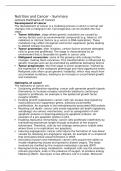Nutrition and Cancer – Summary
Lecture Hallmarks of Cancer
Development of cancer
The development of cancer is a multistep process in which a normal cell
changes into a malignant cell. Carcinogenesis can be divided into four
steps:
Tumor initiation: stage where genetic mutations are caused by
various factors such as environmental compounds (e.g. tobacco, UV-
radiation) or intrinsic factors (e.g. errors in DNA replication). These
mutations may affect oncogenes and tumor suppressor genes leading
to altered cellular functions
Tumor promotion: after initiation, certain factors promote damaged
cells to grow and proliferate. The stage is characterized by an
environment that is favorable for gowth in cancer cells.
Malignant conversion: some of the growing cells undergo further
changes, making them cancerous. This transformation is influenced by
genetic changes and can be promoted by additional damaging factors
Tumor progression: the final stage is tumor progression, marked by
the expression of the malignant phenotype and more aggressive traits.
Malignant cells often cause genomic instability, which may result from
accumulated mutations, leading to an increase in uncontrolled growth
and metastasis.
Hallmarks of cancer
The hallmarks of cancer are:
Sustaining proliferative signaling: cancer cells generate growth signals
themselves or increase receptor sensitivity leading to continuous
signals to proliferate. An example is the epidermal growth factor
receptor (EGFR).
Evading growth suppressors: cancer cells can escape stop signals by
inactivating tumor suppressor genes, allowing uncontrolled
proliferation. An example is the retinoblastoma-associated (RB) protein.
Resisting cell death: cancer cells evade regulated cell death (apoptosis,
autophagy) via various mechanisms, such as upregulation of anti-
apoptotic proteins or downregulating pro-apoptotic proteins. An
example of a pro-apoptotic protein is p53.
Enabling replicative immortality: cancer cells proliferate indefinitely by
maintaining telomerase length through activation of the enzyme
telomerase. Therefore, cells do not undergo senescence (viable state
where there is no replication) nor apoptosis.
Inducing angiogenesis: cancer cells induce the formation of new blood
vessels by releasing pro-angiogenic signals. An example of a compound
that stimulates blood vessel formation is VEGF.
Activating invasion and metastasis: cancer cells acquire the ability to
invade neighboring tissues and spread to distant organs. The steps
involved are clarified by the invasion-metastasis cascade (EMT).
Reprogramming energy metabolism: malignant cells use the anaerobe
process glycolysis, even in the presence of oxygen, to produce energy
(Warburg effect). Glycolysis is less efficient, but it is faster. Moreover,
, intermediates are produced which are used by cancer cells for proteins,
DNA and lipids to support proliferation. Besides, lactose is produced
and can be used as energy source by the cancer cells.
Evading immune destruction: cancer cells evade immune surveillance
by downregulating antigen presentation, secretion of
immunosuppressive molecules or recruiting immune cells to inhibit the
response.
Genome instability and mutation (enabling): genomic instability
provides a favorable situation for mutations in oncogenes and tumor
suppressor genes, accelerating tumor progression.
Tumor-promoting inflammation (enabling): chronic inflammation
contributes to tumor development by creating a favorable
environment. Inflammatory cells release growth, survival, and enzyme
factors that promote angiogenesis and invasion.
Invasion-metastasis cascade
The invasion-metastasis cascade is a multistep process, describing the
steps involved in cancer spread:
1. Primary invasion
2. Local invasion: cancer cells invade from the primary tumor into nearby
tissues.
3. Intravasation: tumor cells penetrate into blood or lymphatic vessels.
4. Circulation: cancer cells travel through the bloodstream or lymphatic
system to distant sites.
5. Extravasation: cancer cells exit the
vessels and enter new tissues.
6. Micro metastasis: small clusters of
cancer cells establish themselves at
the new site.
7. Metastatic colonization: micro
metastases grow into larger, clinically
detectable tumor known as macro
metastases.
Epithelial-to-mesenchymal transition (EMT)
EMT is the molecular process that facilitates the metastatic behavior of
the cancer cells. EMT involves a phenotypic shift where epithelial cells
transform into mesenchymal cells.
Epithelial cells are normally well-organized, with defined borders and
strong adhesion molecules that keep them tightly bound to one another.
During EMT, this organized structure breaks down. Epithelial cells lose
their characteristic tight junctions and adhesion markers, becoming more
like mesenchymal cells.
Mesenchymal cells are less organized and more capable of movement,
which enhances their ability to invade surrounding tissues and migrate to
distant sites. They also express markers like CD73. The reduction in
adhesion molecules is a key indicator of
, this transition, enabling cancer cells to detach their original location and
spread throughout the body.
Diet and carcinogenesis
Diet impacts carcinogenesis. A study showed that rural Africans who
consume a high fiber, low protein/fat diet, have a lower risk on colorectal
cancer compared to American Africans who consume a diet high in
protein/fat, low in fiber. The change in diet influenced the proliferation
rates of epithelial cells, suggesting that diet may modulate cancer risk
though various mechanisms.
Oncogenes and tumor suppressor genes
Oncogenes are mutated forms of genes that promote cell growth and
survival; they increase the rate of cell division. Examples are EGFR, MYC
and RAS.
Tumor suppressor genes normally inhibit cell growth and promote
apoptosis. Mutations in these genes may lead to uncontrollable cell
growth. Examples are p53, RB protein, APC and BRCA1/2.





